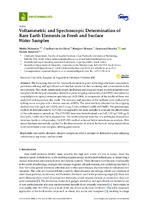| dc.contributor.author | Makombe, Martin | |
| dc.contributor.author | van der Horst, Charlton | |
| dc.contributor.author | Silwana, Bongiwe | |
| dc.contributor.author | Iwuoha, Emmanuel | |
| dc.contributor.author | Somerset, Vernon | |
| dc.date.accessioned | 2018-10-15T07:51:25Z | |
| dc.date.available | 2018-10-15T07:51:25Z | |
| dc.date.issued | 2018 | |
| dc.identifier.citation | Makombe, M. et al. (2018). Voltammetric and spectroscopic determination of rare earth elements in fresh and surface water samples. Environments, 5: 112 | en_US |
| dc.identifier.issn | 2076-3298 | |
| dc.identifier.uri | http://dx.doi.org/10.3390/environments5100112 | |
| dc.identifier.uri | http://hdl.handle.net/10566/4118 | |
| dc.description.abstract | The increasing demand for rare earth elements in green technology, electronic components,
petroleum refining, and agricultural activities has resulted in their scattering and accumulation in the
environment. This study determined cerium, lanthanum and praseodymium in environmental water
samples with the help of adsorptive differential pulse stripping voltammetry (AdDPSV) and inductive
coupled plasma-optical emission spectroscopy (ICP-OES). A comparison of the results of these two
analytical techniques was also made. The accuracy and precision of the methods were evaluated by
spiking water samples with a known amount of REEs. The detection limit obtained for the stripping
analysis was 0.10 g/L for Ce(III), and 2.10 g/L for combined La(III) and Pr(III). The spectroscopic
method of determination by ICP-OES was applied to the same samples to evaluate the effectiveness
of the voltammetry procedure. The ICP-OES detection limit obtained was 2.45, 3.12 and 3.90 g/L
for Ce(III), La(III) and Pr(III), respectively. The results obtained from the two techniques showed low
detection limits in voltammetry; the ICP-OES method achieved better simultaneous analysis. This
sensor has been successfully applied for the determination of cerium, lanthanum, and praseodymium
in environmental water samples, offering good results. | en_US |
| dc.language.iso | en | en_US |
| dc.publisher | MDPI | en_US |
| dc.rights | © 2018 by the authors. Licensee MDPI, Basel, Switzerland. This article is an open access
article distributed under the terms and conditions of the Creative Commons Attribution
(CC BY) license (http://creativecommons.org/licenses/by/4.0/). | |
| dc.subject | Rare earths elements | en_US |
| dc.subject | Alizarin complexon (ALC) | en_US |
| dc.subject | Adsorptive differential pulse stripping voltammetry | en_US |
| dc.subject | Tap water | en_US |
| dc.subject | Surface water | en_US |
| dc.title | Voltammetric and spectroscopic determination of rare earth elements in fresh and surface water samples | en_US |
| dc.type | Article | en_US |
| dc.privacy.showsubmitter | FALSE | |
| dc.status.ispeerreviewed | TRUE | |

